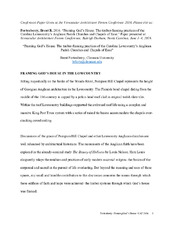Framing God’s House: The timber-framing practices of the Carolina Lowcountry’s Anglican Parish Churches and Chapels of Ease
| dc.creator | Fortenberry, Brent R. | |
| dc.date.accessioned | 2020-02-27T23:32:48Z | |
| dc.date.available | 2020-02-27T23:32:48Z | |
| dc.date.issued | 2020-02-27 | |
| dc.identifier.uri | https://hdl.handle.net/1969.1/187443 | |
| dc.description.abstract | Houses of worship formed the backbone of colonial society in the New World. They functioned both as sites of religious devotion as well as spaces of social interactions–merging the sacred and secular. The Lowcountry of South Carolina and Georgia retains one of the best assemblages of colonial Anglican architecture from the 18th and 19th centuries. While these structures are monuments to Anglican (and later Episcopal) religiosity they also articulate the broader rhythms of the Lowcountry’s vernacular timber-framing tradition. This paper brings together framing data from ten Anglican Parish Churches, and Chapels of Ease from both Charleston’s urban context and the parishes of the Lowcounty recorded using both traditional hand measurements as well as 3D point cloud data. In doing so, it interprets the framing solutions that Lowcountry builders devised on how to best enclose their colonial sacred spaces in both city and country and how those choices changed over time. More broadly this work further explores the emergence of the region’s vernacular traditions within the context of Early Modern English Atlantic building practices as it relates to the period’s notions of Anglican practices and beliefs. | en |
| dc.language.iso | en_US | |
| dc.subject | Vernacular Architecture | en |
| dc.subject | Church | en |
| dc.subject | Timber-Framing | en |
| dc.subject | South Carolina | en |
| dc.title | Framing God’s House: The timber-framing practices of the Carolina Lowcountry’s Anglican Parish Churches and Chapels of Ease | en |
| dc.type | Presentation | en |
| local.department | Architecture | en |


